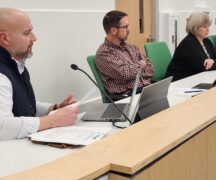By JAN LARSON McLAUGHLIN
BG Independent News
It’s taken some boots on the ground to come up with a plan to make it safer for students to walk or bike to and from school in Bowling Green.
And next week, city and school leaders want to hear from residents about the effort to develop a Safe Routes to School plan. The community is invited to a public input meeting on Wednesday, Jan. 10, from 5 to 6 p.m., at the Veterans Building in City Park.
The Safe Routes to School travel plan is being developed with guidance from a 15-member committee composed of city and school officials, representing all Bowling Green public and nonpublic/parochial schools.
Last year, Mayor Mike Aspacher mentioned the study in his State of the City Address, and City Council followed by appropriating $50,000 for a Safe Routes to Schools travel plan and study.
The city contracted with consultants, who gathered input from public and private schools throughout the city, evaluated community needs for improving safety, and drafted school travel plans.
Local planning consultants Reveille and Mannik Smith Group have been assisting the city in the plan’s development, meeting with school officials, and identifying areas along critical routes to schools in need of safety upgrades. The recommended infrastructure and non-infrastructure countermeasures will be reviewed during the public input meeting with opportunities for comment and feedback.
As part of the study process, the city’s Public Works Director Mick Murray organized visits from the consultants at every school. From each school building, the consultants and school officials took a walk.
“They walked the routes that are most heavily traveled,” said Amanda Gamby, the city’s acting communications director. “They looked at it as students and parents walking to school.”
School officials pointed out known problems along the routes, and noted other issues as they walked.
With the plan taking shape, the schools and city can apply for Safe Routes to Schools programming grants, and the city will be eligible to apply for SRTS infrastructure grants.
The infrastructure grants may fund projects connecting missing sections of sidewalk, bicycle accommodations, pedestrian crossing improvements and more. Infrastructure grants fund 100% of eligible projects, up to $500,000 each year.
“The whole community benefits from efforts to enable and encourage more children to walk, bike or roll to school safely,” Aspacher said. “Bowling Green is committed to taking the long-term steps necessary to activating the community through multi-model/pedestrian connectivity solutions.”
“I look forward to the completion of this plan so that we can begin the next phase, which will include securing additional funding necessary to continue ongoing safety improvements along some of our most critical routes,” Aspacher said.
Those who are unable to attend the public input meeting next week may email comments or ideas to Gamby at agamby@bgohio.org by Jan. 24.
The goal of Ohio’s Safe Routes to School Program is to assist communities in developing and implementing projects and programs that encourage and enable children in grades K-12, including those with disabilities, to walk or bike to school safely.
The plan is centered around developing programs and solutions that follow Ohio Department of Transportation’s five “E” issues that include education, encouragement, enforcement, engineering, and evaluation.
A comprehensive approach to SRTS includes both infrastructure and non-infrastructure countermeasures and programs.
This program is funded at $5 million annually, with money available for:
- Infrastructure projects within two miles of schools serving K-12 students. ODOT will reimburse up to 100% of eligible costs for all phases, including preliminary engineering, detailed design, right-of-way, construction, and construction engineering. Project limit: $500,000.
- Non-infrastructure activities such as education, encouragement, enforcement or evaluation. Non-infrastructure funding may be requested for assistance with the development of plans. ODOT will reimburse up to 100% of eligible costs for items such as training and materials, program supplies, small safety and education incentives, and public awareness campaigns. Project limit: $60,000 or $120,000 for a two-year project.
Safe Routes to School: https://www.transportation.ohio.gov/programs/safe-routes-srts/safe-routes-to-school-srts


